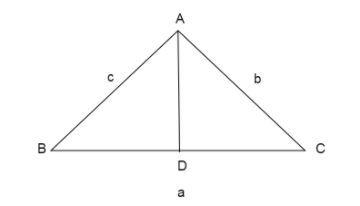
Find the length of the bisector of angle A in a triangle ABC.
A. \[\dfrac{{2bc\sin (A/2)}}{{b + c}}\]
B.$\dfrac{{2bc\cos (A/2)}}{{b + c}}$
C. $\dfrac{{abc}}{{2R(b + c)}}\csc (A/2)$
D. $\dfrac{{4\Delta }}{{b + c}}\csc (A/2)$
Answer
483.3k+ views
Hint: Here the properties of bisector are the only information which we use to reach the solution, which are as follows:
* Bisector of an angle A is defined to be the line cutting off A into equal halves which meets the
opposite side. In the below figure, AD is the bisector of angle A. Thus it divides angle A into 2 equal
halves and meets the opposite side BC.

* Bisector of an angle of a triangle divides the opposite side in the ratio of the sides containing the angle.
Implies point D divides BC into the ratio of sides containing angle A which are AC and AB. Thus
$\dfrac{{BD}}{{DC}} = \dfrac{{AC}}{{AB}}$
* Sine rule: Ratios of a side to corresponding opposite angles are equal. $\dfrac{{AB}}{{\sin C}} = \dfrac{{AC}}{{\sin B}} = \dfrac{{BC}}{{\sin A}}$
Complete step-by-step answer:
We start with bisector AD and develop its relation with the interior angles.
Sine rules on the triangle ABD gives the result: $\dfrac{{AD}}{{\sin B}} = \dfrac{{BD}}{{\sin (A/2)}}$
From the property of bisector and sine rule, $BD = \dfrac{c}{{b + c}}a$
$AD = \dfrac{{ca}}{{b + c}}\dfrac{{\sin B}}{{\sin (A/2)}}$
Multiplying numerator and denominator by $2\cos (A/2)$, for simplifying the equation to shorter terms.
$AD = \dfrac{{ca.\sin B.2\cos (A/2)}}{{(b + c)\sin (A/2).2\cos (A/2)}}$
Using the formula $\sin (2\theta ) = 2\sin \theta \cos \theta $ ,
$AD = 2.\dfrac{{ca.\sin B.\cos (A/2)}}{{(b + c)\sin A}}$
Using sine rule: $\dfrac{a}{{\sin A}} = \dfrac{b}{{\sin B}}$ we get,
$
AD = 2.\dfrac{{cb\sin B\cos (A/2)}}{{(b + c)\sin B}} \\
= \dfrac{{2cb\cos (A/2)}}{{b + c}} \\
$
From the property of bisector and sine rule,
$AD = \dfrac{{2bc}}{{b + c}}\dfrac{{\cos (A/2)\sin (A/2)}}{{\sin (A/2)}}$
Simplifying,
$AD = \dfrac{{bc}}{{\sin (A/2)}}\dfrac{{\sin A}}{{\sin (A/2)}}$
Using $\sin A = \dfrac{a}{{2R}}$ , $\dfrac{1}{{\sin (A/2)}} = \csc (A/2)$ we get,
$AD = \dfrac{{abc}}{{2R(b + c)}}\csc (A/2)$
As $R = \dfrac{{abc}}{{4\Delta }}$
$AD = \dfrac{{abc.4\Delta }}{{2abc(b + c)}}\csc (A/2)$
Simplifying,
$AD = \dfrac{{2\Delta }}{{b + c}}\csc (A/2)$
So, the correct answer is “Option B” and “Option C”.
Note: Students are likely to make mistakes while substituting the sides using the sine formula, always keep in mind the angle opposite to the side comes in denominator along with the side in the numerator. Making the rearrangements of terms according to our motive is to be done properly for a quick solution. Multiplying and dividing by needed trigonometric terms can cut short the solution into simpler form lines.
* Bisector of an angle A is defined to be the line cutting off A into equal halves which meets the
opposite side. In the below figure, AD is the bisector of angle A. Thus it divides angle A into 2 equal
halves and meets the opposite side BC.

* Bisector of an angle of a triangle divides the opposite side in the ratio of the sides containing the angle.
Implies point D divides BC into the ratio of sides containing angle A which are AC and AB. Thus
$\dfrac{{BD}}{{DC}} = \dfrac{{AC}}{{AB}}$
* Sine rule: Ratios of a side to corresponding opposite angles are equal. $\dfrac{{AB}}{{\sin C}} = \dfrac{{AC}}{{\sin B}} = \dfrac{{BC}}{{\sin A}}$
Complete step-by-step answer:
We start with bisector AD and develop its relation with the interior angles.
Sine rules on the triangle ABD gives the result: $\dfrac{{AD}}{{\sin B}} = \dfrac{{BD}}{{\sin (A/2)}}$
From the property of bisector and sine rule, $BD = \dfrac{c}{{b + c}}a$
$AD = \dfrac{{ca}}{{b + c}}\dfrac{{\sin B}}{{\sin (A/2)}}$
Multiplying numerator and denominator by $2\cos (A/2)$, for simplifying the equation to shorter terms.
$AD = \dfrac{{ca.\sin B.2\cos (A/2)}}{{(b + c)\sin (A/2).2\cos (A/2)}}$
Using the formula $\sin (2\theta ) = 2\sin \theta \cos \theta $ ,
$AD = 2.\dfrac{{ca.\sin B.\cos (A/2)}}{{(b + c)\sin A}}$
Using sine rule: $\dfrac{a}{{\sin A}} = \dfrac{b}{{\sin B}}$ we get,
$
AD = 2.\dfrac{{cb\sin B\cos (A/2)}}{{(b + c)\sin B}} \\
= \dfrac{{2cb\cos (A/2)}}{{b + c}} \\
$
From the property of bisector and sine rule,
$AD = \dfrac{{2bc}}{{b + c}}\dfrac{{\cos (A/2)\sin (A/2)}}{{\sin (A/2)}}$
Simplifying,
$AD = \dfrac{{bc}}{{\sin (A/2)}}\dfrac{{\sin A}}{{\sin (A/2)}}$
Using $\sin A = \dfrac{a}{{2R}}$ , $\dfrac{1}{{\sin (A/2)}} = \csc (A/2)$ we get,
$AD = \dfrac{{abc}}{{2R(b + c)}}\csc (A/2)$
As $R = \dfrac{{abc}}{{4\Delta }}$
$AD = \dfrac{{abc.4\Delta }}{{2abc(b + c)}}\csc (A/2)$
Simplifying,
$AD = \dfrac{{2\Delta }}{{b + c}}\csc (A/2)$
So, the correct answer is “Option B” and “Option C”.
Note: Students are likely to make mistakes while substituting the sides using the sine formula, always keep in mind the angle opposite to the side comes in denominator along with the side in the numerator. Making the rearrangements of terms according to our motive is to be done properly for a quick solution. Multiplying and dividing by needed trigonometric terms can cut short the solution into simpler form lines.
Recently Updated Pages
What percentage of the area in India is covered by class 10 social science CBSE

The area of a 6m wide road outside a garden in all class 10 maths CBSE

What is the electric flux through a cube of side 1 class 10 physics CBSE

If one root of x2 x k 0 maybe the square of the other class 10 maths CBSE

The radius and height of a cylinder are in the ratio class 10 maths CBSE

An almirah is sold for 5400 Rs after allowing a discount class 10 maths CBSE

Trending doubts
Write an application to the principal requesting five class 10 english CBSE

Difference between mass and weight class 10 physics CBSE

What is Commercial Farming ? What are its types ? Explain them with Examples

What are five examples of facts and opinions class 10 english CBSE

Which state has the longest coastline in India A Tamil class 10 social science CBSE

10 examples of evaporation in daily life with explanations




